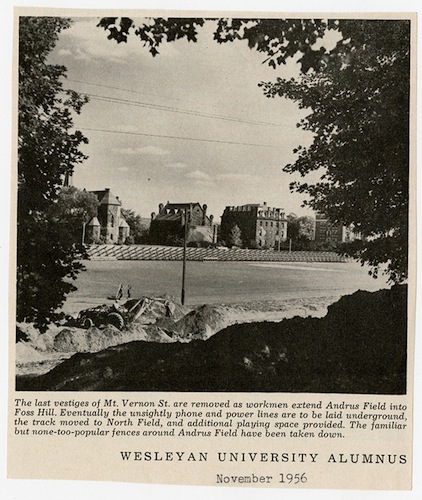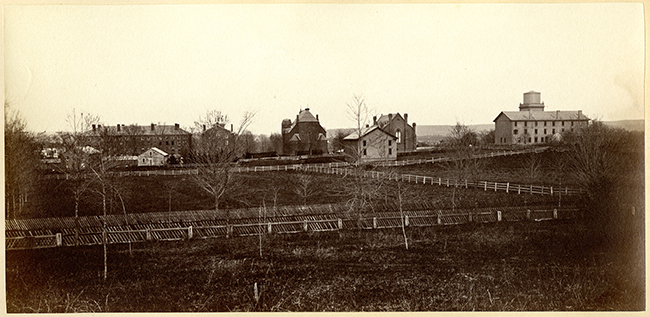By Grant Tillinghast
Foss Hill, now a central part of the Wesleyan University campus in Middletown, Connecticut, underwent significant changes throughout the evolution of the university. Situated between the Foss Hill dormitories and Andrus Field (the oldest continually used football field in the United States), Foss Hill is a vibrant place, home to festivals, concerts, games, and numerous less-organized leisure activities. This majestic hill in the interior of campus serves not only as a home for students, but as an icon of campus life and learning. The changing nature of Foss Hill reflects evolving cultural influences that altered the landscapes of universities across the country.
From Vernon Hill to Foss Hill
Back in the mid-19th century, Foss Hill was an entirely different playing field, called Vernon Hill (after the street that ran along its foot, Mt. Vernon Street). A changing of its name signified the beginning of the hill’s association with Wesleyan University. Archibald C. Foss, professor of Latin and Hebrew (and brother of Wesleyan University President Cyrus Foss) bought a small house on the hill in 1860. When Archibald C. Foss died in 1870, his widow, Caroline, continued to live there. The residence became known as “Foss House,” and the name of the hill changed from Vernon Hill to Foss Hill. Mrs. Foss stopped living there a decade after her husband’s death, and in 1880 politician and alumnus George Seney purchased it for the university.
Once the Foss House ceased to house the Foss family, it quickly became a central feature of campus life. Several fraternities utilized the structure, including: Chi Psi from 1883 to 1893 and Phi Rho from 1894 to 1899. The Commons Club then used it (from 1900 to 1919) to create a place for students not in fraternities to have food, writing programs, and social activities. The Commons Club affiliated with similar clubs at Tufts, Middlebury, and Union Norwich that also provided an alternative to fraternity living. For the next 20 years, the versatile structure then accommodated an infirmary. In 1955, officials removed the house altogether for a new and ambitious project meant to expand the campus and forever alter the local landscape.
Baby Boomers Bring Change To Wesleyan
In 1956, in response to America’s rapidly expanding population, President Butterfield lifted his 750-student cap on enrollment and the university expanded its various forms of student housing. Officials at Wesleyan agreed on locating a new building on the top of Foss Hill. Construction tore up the road that ran below the hill, Mt. Vernon Street, to accommodate these changes. Workers began clearing the fences that surrounded the road and burying nearby power lines, resulting in the relocation of the university’s track from Andrus Field to North Field. President Butterfield’s desire to increase the vitality of campus life by admitting more students spawned these changes to the environment. The changes that took place following the demolition of Mt. Vernon Street brought large events to the hill that included concerts by such acts as The Grateful Dead and Phish.

Photo of the construction to tear down Mt. Vernon Street. View from the trees of Foss Hill, 1956 – Wesleyan University, Olin Library, Special Collections & Archives, Vertical Files Collection, Andrus Field folder
But spectators did not just come to Foss for the music. Students and visitors alike sat on the hill to watch baseball games, Frisbee practice, and other sporting events. The hill became a symbol of all that Wesleyan offered geographically, socially, and culturally. Today, the guided tours of Wesleyan essentially conclude at Foss Hill, allowing prospective students and their families time to take in views of the cultural center of the Wesleyan campus.
Grant Tillinghast authored this piece while a student at Wesleyan University as part of a class project in environmental history.










